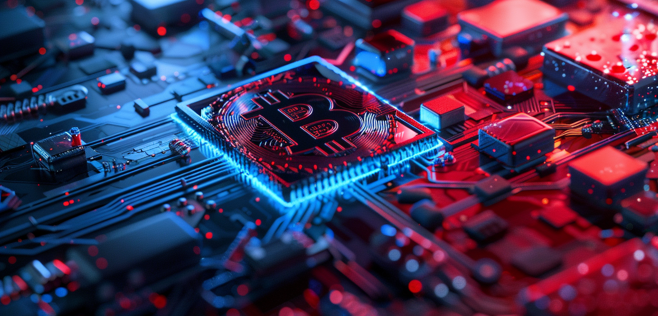Published: 07 Oct 2024
Blockchain and Intellectual Property: Securing Rights in a Digital World

Intellectual property (IP) plays a crucial role in driving innovation and economic growth in today’s global economy. From patents and copyrights to trademarks and trade secrets, IP ensures that creators and innovators are recognized and rewarded for their work. However, the protection and management of IP have become increasingly challenging, particularly in a digital landscape where piracy, counterfeiting, and unauthorized use are rampant.
Enter blockchain technology — a revolutionary solution with the potential to address these challenges. With its decentralized, transparent, and immutable nature, blockchain offers a new way to protect and manage intellectual property assets more efficiently and securely.

Intellectual Property: Types and Modern Challenges
Intellectual property encompasses a wide range of creations, from inventions and designs to literary works and trademarks. The main types of IP include:
- Copyrights: Protecting original works such as books, music, films, and software.
- Patents: Safeguarding new inventions and technologies, giving inventors exclusive rights to their creations.
- Trademarks: Ensuring the distinctiveness of brand names, logos, and symbols that represent products or services.
- Trade Secrets: Guarding confidential business information, such as formulas, strategies, or processes that offer a competitive edge.
In today’s digital era, IP faces significant challenges. Piracy and counterfeiting have surged, particularly in industries like entertainment and fashion, where digital copies and fake products can be widely distributed. Unauthorized use and infringement also pose ongoing problems, with IP owners often struggling to enforce their rights across borders and digital platforms.
These challenges highlight the urgent need for innovative solutions to strengthen IP protection and management, ensuring that creators and businesses can safeguard their assets in an increasingly interconnected world.

Blockchain’s Key Features for Strengthening IP Protection
Blockchain technology offers several core features that make it well-suited for addressing intellectual property challenges. These include:
- Immutability
Once data is recorded on a blockchain, it cannot be altered or tampered with. This is crucial for intellectual property protection as it creates an unchangeable record of ownership, ensuring that IP rights are provable and timestamped from the moment of creation.
- Decentralization
Traditional IP databases are often centralized, making them vulnerable to hacking or manipulation. Blockchain, being decentralized, removes the single point of failure, distributing the control of information across multiple nodes, which enhances security and trust in the system.
- Transparency
Blockchain’s open ledger system allows for transparent tracking of ownership and transfers of IP rights. This means that stakeholders can easily verify the legitimacy and history of intellectual property, helping to reduce disputes over ownership or unauthorized use.
An additional benefit is the use of smart contracts, which can automate complex IP processes such as licensing agreements and royalty distributions. By encoding these agreements into the blockchain, smart contracts ensure that royalties are automatically paid out to the rightful owners based on predefined conditions, reducing the risk of human error or fraud.

Practical Applications of Blockchain in Intellectual Property Management
As blockchain technology continues to evolve, it is finding practical applications in various areas of intellectual property management. By addressing long-standing challenges related to registration, ownership, and enforcement, blockchain provides innovative solutions that enhance transparency and security. Below are some key use cases where blockchain is already making an impact in IP management:
- Patent Management
Blockchain can revolutionize the patent registration process by creating a secure, immutable record of patent ownership. This helps to simplify the tracking of patent lifecycles, from application to approval, and ensures that the rightful owner is always credited. Some patent offices are already experimenting with blockchain to create digital patent records, which can be easily accessed and verified, preventing disputes over ownership or originality.
- Copyright Protection
Unauthorized copying and distribution of digital content are major issues for creators and rights holders. Blockchain offers a solution by embedding proof of ownership and rights within the digital file itself. Blockchain-based copyright systems are being developed for industries like music, art, and media, allowing creators to securely distribute their work while ensuring they receive proper credit and compensation for its use.
- Trademark Registration
Trademarks are critical for brand protection, but ensuring their global validity can be a challenge. Blockchain can be used to verify trademark registrations and protect brands from counterfeiting by providing a transparent and decentralized record of ownership. This is especially useful in cross-border disputes where verifying the legitimacy of a trademark in different jurisdictions can be complex.
In each of these use cases, blockchain not only improves efficiency but also enhances trust between stakeholders, ensuring that intellectual property is properly managed and protected. By leveraging blockchain, industries can safeguard valuable IP assets while reducing costs and minimizing disputes.

Advantages of Blockchain for Intellectual Property Protection
Blockchain technology offers several significant benefits for the protection and management of intellectual property. These advantages not only address current challenges but also open up new possibilities for global and efficient IP management. Below are some key benefits:
- Proof of Ownership
Blockchain’s immutable and time-stamped records provide indisputable proof of ownership for intellectual property assets. This makes it easier for creators and rights holders to defend their ownership in the event of legal disputes. Whether it’s a patent, copyright, or trademark, blockchain ensures that there is a clear, unalterable record of who owns the rights to a particular IP.
- Reduced Costs and Time
Traditional IP registration processes can be slow and costly, involving extensive paperwork and administrative overhead. Blockchain streamlines these processes by digitizing IP records and using smart contracts to automate key functions such as licensing and royalty payments. This not only reduces the time it takes to register and manage IP but also lowers associated costs for rights holders and companies.
- Global Accessibility
IP protection often varies by jurisdiction, making it difficult to enforce rights across borders. Blockchain’s decentralized nature allows for seamless, global accessibility to IP records, ensuring that rights are recognized and protected internationally. This helps industries and innovators collaborate across regions and jurisdictions, while also offering more robust protection against infringement in global markets.
By adopting blockchain, IP holders can enjoy stronger, more efficient protection, lower costs, and the ability to manage their intellectual property assets on a global scale.

Challenges and Limitations of Blockchain in IP Management
While blockchain presents significant potential for enhancing intellectual property protection, it also faces several challenges and limitations that must be addressed for widespread adoption. These include legal, regulatory, and technological barriers that may complicate its implementation in existing IP frameworks:
- Legal and Regulatory Issues
The use of blockchain for IP management raises several legal questions. Current IP laws may not fully accommodate blockchain-based records, leading to uncertainty around the enforceability of blockchain records in legal disputes. Jurisdictional differences in IP law can also create complications, particularly in cross-border cases, where varying legal frameworks may not recognize blockchain-based proof of ownership or licensing agreements.
- Adoption Barriers
Traditional IP systems and stakeholders may resist the adoption of blockchain due to a lack of familiarity with the technology. Many organizations are not aware of how blockchain could benefit IP management, or they may be hesitant to invest in the cost and complexity of integrating it into their existing infrastructure. This can slow down the adoption process, particularly among industries with well-established but outdated IP protection processes.
- Technological Constraints
Blockchain technology, while powerful, still faces limitations in terms of scalability and data storage. Managing large volumes of IP records across global networks may strain existing blockchain infrastructures. Additionally, there are privacy concerns, particularly in cases where sensitive IP information may need to be stored or shared. Permissioned blockchains, which offer more privacy control, could mitigate this issue but may reduce the decentralization benefits of public blockchains.
Overcoming these challenges will be key to realizing blockchain’s full potential in the IP sector. Addressing regulatory concerns, promoting awareness, and developing scalable, secure blockchain solutions are necessary steps toward broader adoption in the global IP landscape.

Future Trends and Developments in Blockchain and IP
As blockchain technology continues to evolve, several trends and innovations are shaping its role in intellectual property management. One promising development is the rise of decentralized IP marketplaces, where creators can directly license, sell, or trade their IP assets through blockchain platforms. These marketplaces enable frictionless transactions and greater control for creators. NFTs (non-fungible tokens) are playing a significant role in this space, providing a secure and verifiable method for representing and transferring ownership of digital and physical IP assets.
Additionally, the integration of AI and blockchain holds immense potential for enhancing IP protection. AI can automate processes like infringement detection, further improving the speed and accuracy of IP management. As blockchain-based IP systems mature, we can expect even more advanced tools that combine AI’s analytical capabilities with blockchain’s transparency and immutability. This synergy could revolutionize IP enforcement and monitoring on a global scale.
Looking ahead, global standards and collaboration will be crucial to unlocking the full potential of blockchain in IP protection. There is a growing push for unified standards to facilitate the seamless use of blockchain across international borders, making it easier for IP owners to protect their assets globally. Several international organizations are already working to establish these frameworks, aiming to create a more consistent, reliable approach to blockchain-based IP management.
Blockchain technology has the potential to transform the way intellectual property is protected and managed. Its features, such as decentralization, transparency, and automation, offer solutions to many of the current challenges in the IP space. As decentralized marketplaces, AI integration, and global standards continue to develop, blockchain will likely play an increasingly important role in creating a more secure, efficient, and transparent IP ecosystem.

 Get RateX Pro
Get RateX Pro

 06 Jun 2024
06 Jun 2024


